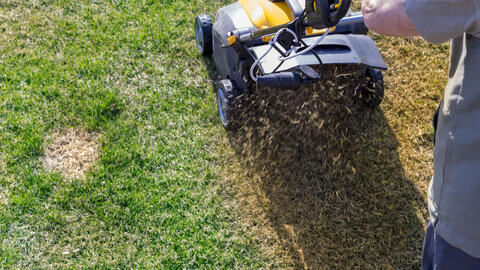The 3 Most Common Lawn Care Mistakes
Whether mowing, fertilizing or dethatching: Here are the most common lawn care mistakes - and how you can avoid them.

Lawn care mistakes occur in particular when detatching
Mistakes in lawn care quickly lead to holes in the turf, weeds, and unattractive, yellowish-brown discolored areas - for example when mowing the lawn, fertilizing, and dethatching. We explain here what hobby gardeners get wrong most often and tell you how to avoid the same mistakes.
If you value a neat lawn, you should make sure you mow it frequently. Otherwise, you’ll end up having to cut off too much leaf mass in one go. The grass will subsequently not form as many shoots and lawn weeds such as clover and speedwell could spread in the gaps in the turf.
Ideally, the lawn should be cut about every seven days during the main growing period in May and June, and maybe even more frequently. The mowing routine also depends on the weather and the lawn itself, i.e. the seeds used. Lawn areas sown with quality seeds grow a good 0.79 inches each week, while more cost-effective lawn mixes such as “Berliner Tiergarten” grow almost 1.57 inches per week. every week stimulates the branching of the grasses and ensures a dense, healthy, and lush green lawn. Set the mowing height so that the grass is shortened by a maximum of one third. Heavier cutting means the shoots will take too long to regenerate, which promotes weed growth and means the lawn will burn more easily in droughts.

There is a stubborn rumor that fertilizing makes the lawn grown more quickly and therefore increases the amount of care required. It is true that grass naturally has a high nutrient requirement that increases even more through regular lawn mowing and the associated loss of biomass. Failing to fertilize the lawn creates a competitive advantage for weeds - as these can manage with much fewer nutrients and displace weaker grasses in no time at all.
You should fertilize your lawn three to four times a year, as required, or a little less frequently if you regularly use a lawnmower robot or mulch mower. It is important to apply the lawn fertilizer as evenly as possible - a spreader is extremely effective here. Experts begin by carrying out a in order to determine the precise nutrient requirements of the grass and then use oxygen-rich organic or organic-mineral long-term lawn fertilizer with a high potassium, lime, and iron content. You can find suitable products in a trade shop.
The following fertilizing schedule has proven successful for lawn care: Fertilize the lawn for the first time in the spring after the lawn has been mown for the first time. The next nutrients should be administered in June, when the grass grows most vigorously. The third fertilizer dose should be applied in August. A is released from the end of September until mid-October. Fall lawn fertilizers have a high proportion of potassium that increases the frost-hardiness of the lawn and helps it safely through the winter.
Dehatching is simply an integral part of lawn care: It fends off lawn felt and moss, ensures better root aeration and generally makes the lawn more durable and robust. However, making mistakes here can mean all the effort is for nothing. For example, many hobby gardeners set the dethatcher too low. The knives then penetrate deeply into the soil and damage the grass roots. Rule of thumb: The cuts in the turf should be no more than 0.09 to 0.12 inches deep. Re-sowing is also often neglected after dethatching. Lawn weeds then quickly move in to the bare patches left by dethatching. Either left over seeds from the original lawn mix (if they are not too old) or special resowing products from trade shops that quickly close up the gaps in the turf again are suitable for resowing. Sand should also be spread over the lawn area after dethatching. This is particularly important for heavy soils with a high loam content - the roughly 3.94 inch thick layer of building sand on the surface slowly penetrates into the upper soil layer and makes it looser and more permeable. The effect often becomes abundantly clear after three to four years: The lawn will appear more vibrant and moss growth will be significantly suppressed.



